Don't wanna be here? Send us removal request.
Text
WEEK 6: THE INFLUENCES OF SOCIAL MEDIA TOWARD SLOW FASHION MOVEMENT
The intersection of social media and the slow fashion movement has profoundly influenced consumer behavior and industry practices, as explored in the provided articles. Social media platforms serve as powerful tools for promoting awareness and engagement with the principles of slow fashion, reshaping the narrative surrounding sustainability and ethical consumption. According to (Thalmann, 2020), the visual nature of platforms like Instagram and Pinterest facilitates the dissemination of inspirational content, including sustainable fashion brands, eco-friendly products, and ethical production practices. Through visual storytelling and user-generated content, social media channels provide a platform for showcasing the creativity and diversity of sustainable fashion, inspiring followers to adopt more conscious shopping habits.
Additionally, (Akou, 2019) argues that social media enables direct communication between consumers and brands, fostering transparency and accountability within the fashion industry. Consumers can engage with brands on social media, asking questions about sourcing, production methods, and environmental initiatives, thus holding companies accountable for their ethical and sustainable practices. Furthermore, (Gareis, 2021) highlights the role of influencers and content creators in driving awareness and advocacy for slow fashion. Influencers leverage their platforms to promote sustainable fashion brands, share personal experiences, and advocate for responsible consumer behavior, amplifying the message of sustainability to a wider audience.
Additionally, (Riisgaard, 2020) underscores the importance of social media in community-building and peer support within the slow fashion movement. Online communities and forums provide a space for individuals to connect, share resources, and exchange ideas related to sustainable fashion practices, fostering a sense of belonging and collective action. Despite the positive influence of social media on the slow fashion movement, challenges remain in navigating issues such as greenwashing and superficial engagement. As (Thalmann, 2020) notes, the curated nature of social media can sometimes obscure the complexities of sustainability, leading to misconceptions and misinterpretations.
Therefore, (Akou, 2019) emphasizes the importance of critical media literacy skills in discerning genuine sustainability efforts from marketing tactics. In conclusion, social media has emerged as a powerful force for driving awareness and advocacy for the slow fashion movement, empowering consumers to make more informed choices and pushing the fashion industry towards greater transparency and accountability. However, (Gareis, 2021) cautions that sustaining momentum requires ongoing efforts to foster genuine and lasting change in consumer behavior and industry practices, ensuring that the principles of slow fashion are upheld beyond the digital realm.
youtube
Thạch Trang, a Gen Z influencer in the fashion industry, has emerged as a powerful advocate for sustainable fashion practices. Through her engaging videos on remaking clothes and shopping at thrift stores, she has captivated her audience and inspired them to adopt more eco-friendly and ethical fashion habits. By showcasing the creative potential of upcycling and highlighting the value of second-hand shopping, Trang encourages her followers to reconsider their approach to fashion consumption. Her influence extends beyond mere aesthetics, as she empowers her audience to make informed choices that contribute positively to the sustainable fashion industry. Through her efforts, Trang has played a significant role in raising awareness and fostering a community of environmentally conscious consumers who actively support the principles of sustainability in fashion.
References
Ellinor, B., & Alphen Laura, V. (2020). From fast to slow: Can influencers make us shop more sustainably? Digitala Vetenskapliga Arkivet. https://www.diva-portal.org/smash/record.jsf?pid=diva2%3A1436642&dswid=8336
Jacobson, J., & Harrison, B. (2021). Sustainable fashion social media influencers and content creation calibration. International Journal of Advertising, 41(1), 1–28. https://doi.org/10.1080/02650487.2021.2000125
L. Short, H. (2022). Exploring the role of social media influencers in promoting sustainable fashion on twitter - proquest. ProQuest . https://www.proquest.com/openview/62d9401ebb5def537bfdd34635488e36/1?pq-origsite=gscholar&cbl=18750&diss=y
Millward-Pena, I. (2024). From fast fashion to slow sustainable fashion . Electronic Theses, Projects, and Dissertations. https://scholarworks.lib.csusb.edu/etd/1453/
#mda20009#fashion#slowfashion#fastfashion#thrift#remake#clothes#influencers#socialmedia#youtube#Youtube
0 notes
Text
Week 10
The fragility between online harassment and fan serving
Online harassment encompasses various forms of abusive behavior perpetrated through digital channels, including cyberbullying, hate speech, doxxing, non-consensual image sharing, stalking, trolling, and so on. And not a specific group of people such as women or children, but everyone can have the risk to be the victim of online harassment. In this post, I will discuss about harassment and bullying on social media towards celebrities, especially K-pop idols.
Online harassment towards celebrities has emerged as a pervasive and concerning issue in the digital age, exacerbated by the widespread use of social media platforms as conduits for abusive behavior. Research on this topic underscores the heightened vulnerability of celebrities to online harassment due to their elevated public visibility and exposure (Dunne, 2021). This vulnerability is further compounded by the intense scrutiny and criticism that celebrities often face from the public, as well as from dedicated fan communities. According to statistics, cyberbullying affects a significant portion of the population, with over 37% of internet users reporting being cyberbullied at some point (First Site Guide). Celebrities, in particular, are prime targets for cyberbullying, which can manifest in various forms such as hate speech, doxxing, and objectification.
A notable example of this phenomenon is evident in the realm of K-pop, where celebrities often experience intense scrutiny and competition among fans. Research indicates that cyberbullying is prevalent among teenage K-pop fans, with incidents of harassment and bullying occurring within fan communities (Lee & Song, 2021). Additionally, South Korean celebrities face unique challenges due to the highly competitive nature of the entertainment industry and the prevalence of cyberbullying within the country (Novasia GSIS). This environment exacerbates the risk of online harassment for celebrities, impacting their mental health and well-being.
Furthermore, female celebrities are disproportionately targeted for misogynistic harassment and objectification on social media platforms (Chowdhury et al., 2021). The objectification of women celebrities contributes to the perpetuation of harmful stereotypes and reinforces gender-based inequalities. Such harassment not only undermines the dignity and self-esteem of the individuals targeted but also perpetuates a culture of toxicity and intolerance online.
The impact of online harassment on celebrities extends beyond personal well-being to professional reputation and career prospects. Instances of cyberbullying and harassment can tarnish a celebrity's public image, leading to reputational damage and potential loss of opportunities. Therefore, addressing online harassment towards celebrities requires concerted efforts from various stakeholders, including social media platforms, law enforcement agencies, and society at large. By raising awareness, implementing effective policies, and fostering a culture of respect and empathy online, we can strive towards creating a safer digital environment for all users, including celebrities. Below are some case of K-pop idols face with different types of online harassment that cause shock to the K-pop industry.
Being stalked by sasaeng fans
Nayeon (a member of the popular South Korean girl group TWICE) is one of the most famous case of being spammed by stalker or also known as "sasaeng fan" - crazy fans who are overly obsessed with the Hallyu wave (Iwicka, 2018). The article (ChinnuswamyCorrespondent, 2022) reports on a concerning development regarding a long-time stalker of Nayeon. The stalker, who has a history of harassing Nayeon, claims to be in South Korea again, raising alarms among fans and prompting heightened security measures. The stalker has previously attempted to approach Nayeon on multiple occasions, leading to legal action and restraining orders. Despite efforts to ensure Nayeon's safety, the stalker's persistence poses a continuing threat, highlighting the challenges celebrities face in dealing with obsessive and potentially dangerous individuals. The situation underscores the importance of robust security measures and legal protections for celebrities, as well as the need for greater awareness and support to address stalking and harassment in the entertainment industry.
youtube
Deepfake photos
The emergence of deepfake technology and the circulation of fake photos present significant challenges for K-pop idols, as they become targets for malicious manipulation and exploitation. In a disturbing trend, idols' images are edited into 18+ videos, photos, and negative contexts with fabricated titles, and false rumors alleging romantic relationships with other individuals. This digital deception poses a threat to idols' reputations and well-being, as they may face criticism and backlash from social media users who believe the manipulated content. While dedicated fans may discern the truth behind these fabricated materials, the broader online audience may fall prey to misinformation, leading to unwarranted scrutiny and condemnation of the idols. As a result, K-pop idols navigate a precarious digital landscape where their images and identities can be distorted, and their integrity questioned, underscoring the urgent need for vigilance and protective measures to preserve their dignity and privacy.
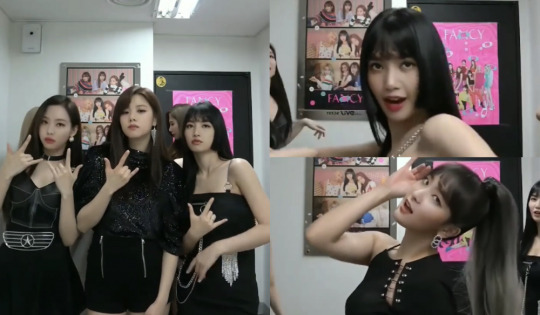
The face of idols are changed with others
Scandals because of fake news
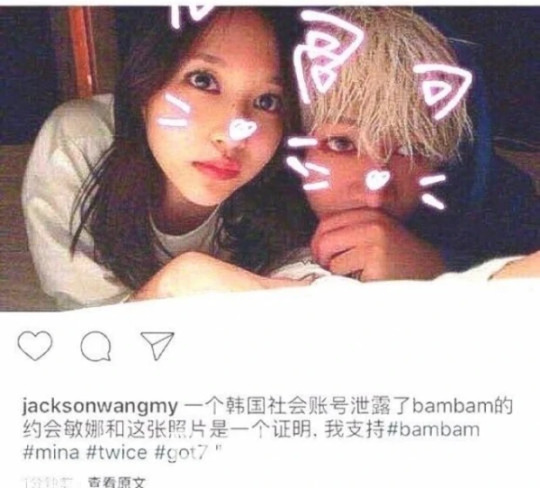
The article (Nghi Vấn Bambam (GOT7) và Mina (TWICE) Hẹn Hò: Lộ Bức Ảnh Thân Thiết Làm Bằng Chứng, 2017) discusses a controversy surrounding a photo allegedly depicting a close moment between Bambam of GOT7 and Mina of TWICE, leading to speculations of a romantic relationship between them. The photo in question sparked discussions among fans, with some interpreting it as evidence of a romantic connection between the two K-pop idols. However, the authenticity and context of the photo remain unclear, and both Bambam and Mina's agencies have not commented on the matter. Despite the lack of official confirmation, the speculation has generated considerable interest and debate within the K-pop community, highlighting the intense scrutiny and rumors that idols often face regarding their personal lives.
The risk of online harassment towards celebrities looms large in the digital age, fueled by the pervasive reach of social media platforms and the anonymity they afford to perpetrators. Celebrities, due to their high visibility and public profiles, are often targets of intense scrutiny and criticism from online users. The consequences of online harassment can be profound, impacting celebrities' mental health, personal well-being, and professional careers. Moreover, the relentless onslaught of negative comments and malicious attacks can erode their self-esteem and lead to feelings of isolation and distress. Despite efforts to mitigate online harassment through platform regulations and legal interventions, the risk remains ever-present, underscoring the need for continued vigilance and support mechanisms to protect celebrities from the perils of online abuse.
youtube
References
Andriani, Rosalyn Anwar, C., Fitriani Akram, N., & Aeni Alimuddin, N. (2020). Cyberbullying among teenage K-pop fans. ResearchGate . https://www.researchgate.net/publication/350635840_Cyberbullying_among_teenage_K-pop_fans/fulltext/6092d9e7a6fdccaebd0dc8cd/Cyberbullying-among-teenage-K-pop-fans.pdf
ChinnuswamyCorrespondent, Y. (2022, September 23). Long-time stalker of Twice singer Nayeon claims to be in South Korea again. The Straits Times. https://www.straitstimes.com/life/entertainment/long-time-stalker-of-twice-singer-nayeon-claims-to-be-in-south-korea-again
Chowdhury, K. (2022). Misogynist internet objectification of women celebrities on social media platforms (facebook) in bangladesh. ResearchGate . https://www.researchgate.net/profile/Kuntala-Chowdhury-4/publication/363469632_Misogynist_Internet_Objectification_of_Women_Celebrities_on_Social_Media_Platforms_Facebook_in_Bangladesh/links/632e488a694dbe4bf4b7dd47/Misogynist-Internet-Objectification-of-Women-Celebrities-on-Social-Media-Platforms-Facebook-in-Bangladesh.pdf
Contributor, Nova. (2022, August 12). Cyberbullying: the case of South Korean celebrities. Novasia. https://novasiagsis.com/cyberbullying-the-case-of-south-korean-celebrities/
Cook, S. (2018, December 7). Cyberbullying statistics and facts for 2016 - 2018 | comparitech. Comparitech; Comparitech. https://www.comparitech.com/internet-providers/cyberbullying-statistics/
Djuraskovic, O. (2023, March 22). FirstSiteGuide team. FirstSiteGuide. https://firstsiteguide.com/cyberbullying-stats/
Dunne, D. (2021). Cyber harassment & celebrities: Exploring personality types, self-efficacy and the types and levels of cyber harassment experienced by celebrities across social media. http://dspace-test.interleaf.ie/bitstream/handle/20.500.12065/3821/Dunne%20D-2021-Cyber%20harassment%20%26%20celebrities-Exploring%20personality%20types%2C%20self-efficacy....pdf?sequence=1&isAllowed=y
Ha , S. (2021). Fans discuss why deepfake is something everyone needs to be worried about. Allkpop. https://www.allkpop.com/article/2021/02/fans-discuss-why-deepfake-is-something-everyone-needs-to-be-worried-about
Iwicka, R. (2018, January 1). Every breath you take: Sasaeng fans. Brill. https://brill.com/display/book/edcoll/9789004365322/B9789004365322-s008.xml
Mendoza, I. (2023, August 14). Ex-Idol reveals how fans sexually harass male stars during shows. International Business Times. https://www.ibtimes.com/ex-idol-reveals-how-fans-sexually-harass-male-stars-during-shows-3708600
Moonbin (ASTRO) bị lộ chuyện muốn “ra đi” từ cách đây 5 năm, lý do khiến fan sốc nặng! (2023). YouTube ; VGT TV - Giải Trí. https://www.youtube.com/watch?v=dnVsLso3G2A
Nghi vấn Bambam (GOT7) và Mina (TWICE) hẹn hò: Lộ bức ảnh thân thiết làm bằng chứng. (2017, March 13). Kenh14. https://kenh14.vn/nghi-van-bambam-got7-va-mina-twice-hen-ho-lo-buc-anh-than-thiet-lam-bang-chung-20170313122452672.chn
#mda20009#kpop#kpopidols#harassment#onlineharassment#stalk#stalker#stalking#nayeon#mina#bambam#twice#deepfake#fakenews#moonbin#suicide#mentalhealth#mental#stress#socialmedia#sasaeng#fan#kpopfan#Youtube
3 notes
·
View notes
Text
WEEK 9
The evolution of gaming community: Breaking stereotypes and Embracing diversity
In recent years, gaming communities, social gaming, and live streaming have experienced a remarkable evolution, reshaping the landscape of the gaming industry and challenging traditional stereotypes. Once perceived as predominantly male-dominated spaces, the gaming world has seen a significant influx of female gamers, challenging outdated perceptions and fostering a more inclusive and diverse gaming culture.
Gaming communities: from exclusivity to inclusivity
Historically, gaming communities were often characterized by exclusivity, with male gamers dominating the scene and perpetuating a culture that alienated female gamers. However, as gaming has become more accessible and mainstream, the demographics of gaming communities have undergone a profound shift. According to a report by Statista, as of 2020, approximately 41% of gamers in the United States were female, highlighting the growing presence of women in the gaming community.
Social gaming: connecting players across borders
Social gaming platforms have played a crucial role in fostering community engagement and connectivity among gamers worldwide. Platforms like Twitch, Discord, and Steam have provided spaces for gamers to connect, communicate, and collaborate with fellow players, transcending geographical boundaries and fostering a sense of camaraderie within the gaming community.
Live streaming: the rise of gaming celebrities
Live streaming has emerged as a dominant force in the gaming industry, providing gamers with a platform to showcase their gameplay, interact with viewers in real-time, and cultivate dedicated fan bases. Influential streamers like Pokimane, Valkyrae, and AnneMunition have risen to prominence, challenging stereotypes and reshaping perceptions of what it means to be a gamer in the digital age.
Challenging stereotypes: the female gamer revolution
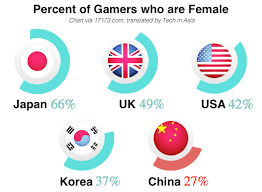
Despite significant progress, female gamers continue to face stereotypes and biases within the gaming community. The stereotype of the "gamer girl" persists, often portraying female gamers as novelties or objects of male fantasy rather than serious players. However, the rise of prominent female streamers, esports athletes, and content creators has challenged these stereotypes, proving that women are just as skilled, passionate, and dedicated to gaming as their male counterparts.
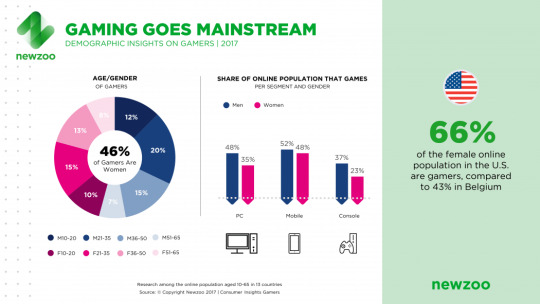
In conclusion, the evolution of gaming communities, social gaming, and live streaming has brought about a paradigm shift in the gaming industry, challenging traditional stereotypes and fostering a more inclusive and diverse gaming culture. While there is still work to be done to combat gender biases and discrimination within the gaming community, the growing presence of female gamers serves as a testament to the power of diversity and representation in shaping the future of gaming. As the gaming landscape continues to evolve, embracing diversity and celebrating the contributions of gamers from all backgrounds will be essential in ensuring a vibrant and inclusive gaming community for generations to come.
youtube
References:
References
Clement, J. (2022). U.S. video gamer gender statistics 2018 | statista. Statista; Statista. https://www.statista.com/statistics/232383/gender-split-of-us-computer-and-video-gamers/
Custer, C. (2013). Tech in asia - connecting asia’s startup ecosystem. Www.techinasia.com. https://www.techinasia.com/what-country-has-the-most-gamer-girls
Hern, A. (2018, November 4). Female gamers: The rise of women in the world of eSports. The Guardian. https://www.theguardian.com/games/2018/nov/04/female-gamers-rise-women-esports
Male and female gamers: How their similarities and differences shape the games market. (2017). New Zoo. https://newzoo.com/resources/blog/male-and-female-gamers-how-their-similarities-and-differences-shape-the-games-market
Statt, N. (2019, April 10). Women in gaming are having a moment. The Verge. https://www.theverge.com/2019/4/10/18304832/women-in-gaming-metoo-gender-equality-sexual-harassment-e3-2018
0 notes
Text
WEEK 7:
The correlation between digital platform and body dysmorphia
This week's readings focus on the influence of social media in shaping contemporary beauty standards. Through this discussion, we aim to understand the intricate relationship between social media, beauy ideals, and their profound impact on mental and physical health.
Body dysmorphia, also known as body dysmorphic disorder (BDD), is a mental health condition characterized by a preoccupation with perceived flaws or defects in physical appearance that are often undetectable to others. Individuals with body dysmorphia experience significant distress and impairment in daily functioning due to their obsessive thoughts about their appearance.
In contemporary society, digital media platforms have become central arenas for the dissemination of beauty standards, often influencing individuals' perceptions of their bodies and driving them towards drastic measures such as plastic surgery. The intersection of digital citizenship and health education in the realm of body modification on visual social media presents a complex landscape where notions of beauty, self-esteem, and digital responsibility intertwine.

Visual social media platforms like Instagram, TikTok, YouTube... are rife with images and videos showcasing idealized standards of beauty. These platforms often feature influencers and celebrities who epitomize these standards, promoting a narrow and often unattainable image of physical perfection. This relentless exposure to curated images can lead to a phenomenon known as "social comparison," where individuals measure their own appearance against those portrayed on social media, often resulting in feelings of inadequacy and low self-esteem.

In this digital landscape, the pressure to conform to societal beauty standards can be overwhelming, leading some individuals to resort to plastic surgery as a means of achieving the desired aesthetic. Cosmetic procedures such as rhinoplasty, breast augmentation, and lip fillers have become increasingly popular, with many citing social media as a primary influence behind their decision to undergo surgery. Studies have shown a correlation between exposure to idealized images on social media and an increased desire for cosmetic enhancement, particularly among younger demographics.
The implications of this phenomenon extend beyond individual choices, raising important questions about digital citizenship and ethical responsibility. Social media platforms have a duty to foster a culture of inclusivity and body positivity, rather than perpetuating harmful beauty standards. Likewise, educators and health professionals play a crucial role in promoting critical media literacy skills and empowering individuals to navigate digital spaces mindfully. Below are some video about social media and influence on our appearance.
The key message of the video "Social Media and Body Image: Mindset Monday" is to encourage viewers to cultivate a positive body image and self-esteem, despite the negative influence of social media. The speaker emphasizes the detrimental effects of comparing oneself to unrealistic beauty standards promoted on platforms like Instagram. She highlights the importance of self-acceptance and self-love, urging viewers to focus on their individual worth and strengths rather than seeking validation from social media. Additionally, the video emphasizes the need for critical thinking and media literacy skills to navigate the digital landscape responsibly and protect one's mental well-being. Overall, the message promotes resilience against the damaging impact of social media on body image and promotes a mindset of self-empowerment and authenticity.
youtube
youtube
The key message of Dove's "Reverse Selfie | Have #TheSelfieTalk" campaign is to encourage audience to change their thinking about the influence of social media on self-esteem and body image. The video portrays a reverse time-lapse showing a young girl's transformation from a confident and happy child to one who feels insecure and pressured to conform to unrealistic beauty standards, as reflected in her selfies. Through this powerful visualization, Dove aims to raise awareness about the negative impact of social media on young people's self-image and mental well-being. The campaign advocates for parents to initiate conversations with their children about self-esteem, body confidence, and the importance of self-acceptance in the face of societal pressures propagated by social media. Ultimately, Dove encourages families to have #TheSelfieTalk to promote positive self-image and resilience against harmful beauty ideals perpetuated online.
In conclusion, the intersection of digital citizenship and health education in the context of body modification on visual social media underscores the need for a nuanced understanding of how digital media shapes perceptions of beauty and influences behavior. By acknowledging the role of social media in perpetuating beauty standards and promoting plastic surgery, we can work towards cultivating a more inclusive and empowering online environment. Empowering individuals to critically engage with digital media and promoting a diverse representation of beauty are essential steps towards fostering a culture of digital citizenship and promoting holistic health and well-being.
Reference:
References
References
Adkins, A. (2018, May 9). How social media contributes to body dysmorphic behavior. The Lexington Line. https://www.thelexingtonline.com/blog/2018/5/7/how-social-media-contributes-to-body-dysmorphic-behaviors
D'Amore Mental Health. (2022, January 26). The relationship between social media and body dysmorphia | d’amore. Damorementalhealth.com. https://damorementalhealth.com/social-media-and-body-dysmorphia/
Gorbis, E. (2019). Does media induce individuals with body dysmorphic disorder (BDD) to have plastic surgery? Adaa.org. https://adaa.org/learn-from-us/from-the-experts/blog-posts/consumer/does-media-induce-individuals-body-dysmorphic
Gupta, M., Jassi, A., & Krebs, G. (2023). The association between social media use and body dysmorphic symptoms in young people. Frontiers in Psychology, 14(1). https://doi.org/10.3389/fpsyg.2023.1231801
Putman, A. (2021, December 20). Social media and body dysmorphic disorder. GreyMattersTU. https://greymattersjournaltu.org/issue-2/social-media-and-body-dysmorphic-disorde
#mda20009#body dysmorphia#dysmorphia#plasticsurgery#social media#beautystandard#bodyimage#beauty#Youtube
0 notes
Text
WEEK 8: Instagram Filters
The correlation between brands and filters on digital sites
According to Oxford Dictionary, is a device, tool, or mechanism used to remove, modify, or enhance certain elements within a system. In their essence, filters are considered digital tools designed to modify or enhance images, often catering to aesthetic preferences or creative expression (Digital Filter, 2023). The main types of filters include automatique, beauty, interaction, and AI filters. Photometric filters enhance image aesthetics, while beauty filters focus on facial enhancement. Interaction filters add dynamic elements to engage users, and AI filters utilize artificial intelligence for sophisticated content modifications. These filters cater to various creative and practical needs in digital content creation (Repetska, 2023).
An AI filter, also known as an artificial intelligence filter, refers to a type of filter that utilizes artificial intelligence (AI) algorithms to modify or enhance digital content, such as images or videos (Repetska, 2023). According to a research, (Sofija, 2023) we can determine that Ai filters have brought about lots of benefits for brands on digital sites. Newly released data reveals that a significant 79% of consumers express a keen interest in utilizing Augmented Reality (AR) for product interaction prior to purchase, while 67% show a similar interest in experiencing AR at events and conferences. Moreover, a substantial 74% of consumers display enthusiasm for AR applications in entertainment contexts like concerts and sporting events. These findings present promising opportunities for brands to connect with consumers through innovative and immersive experiences (Sofija, 2023). Below are numbers showing that brands should apply AI/AR filters into their marketing strategies:
80% of brands leveraging AR report significant benefits, including increased sales, customer acquisition, and enhanced performance metrics.
74% of consumers demonstrate enthusiasm for using AR in entertainment contexts, such as concerts and sports events.
80% of brands utilizing AR filters witness improvements in brand awareness.
Engaging with products featuring AR experiences leads to a staggering 94% higher purchase conversion rate.

TikTok has emerged as a highly effective platform for marketing campaigns due to its unparalleled reach, engagement, and virality. With over a billion active users worldwide, TikTok offers brands an extensive audience base to target and connect with. Its algorithm-driven content discovery mechanism ensures that even relatively unknown brands have the potential to go viral and gain widespread exposure. Moreover, TikTok's emphasis on short-form, visually engaging content encourages creativity and allows brands to convey their messages concisely and impactfully. The platform's diverse range of features, including hashtags, challenges, and filters, provides marketers with ample opportunities to craft innovative and interactive campaigns that resonate with their target demographics. Additionally, TikTok's influencer culture enables brands to collaborate with popular creators to amplify their reach and credibility. Overall, TikTok's dynamic and immersive environment makes it an indispensable platform for marketers seeking to engage with audiences in authentic and memorable ways. The "TikTok Made Me Buy" trend epitomizes the platform's sway over consumer purchasing decisions. Through user-generated content, TikTok users share product recommendations and experiences, sparking viral sensations and driving sales for featured brands (What Is “TikTok Made Me Buy It”?, n.d.). This trend underscores TikTok's influence in shaping consumer preferences and fostering authentic engagement between users and brands.

Gucci's utilization of AI filters on Instagram as part of its marketing strategy exemplifies the brand's innovative approach to engaging with its audience in the digital realm. By leveraging AI technology, Gucci creates captivating and personalized experiences for users, allowing them to virtually try on the brand's products, explore unique visual effects, or interact with branded content in novel ways. These AI filters not only serve as a creative extension of Gucci's brand identity but also foster a sense of exclusivity and allure, enticing followers to actively participate and share their experiences with others. Through this strategic integration of AI filters into its marketing plan, Gucci effectively enhances brand awareness, cultivates a loyal community of followers, and drives meaningful engagement on the Instagram platform.
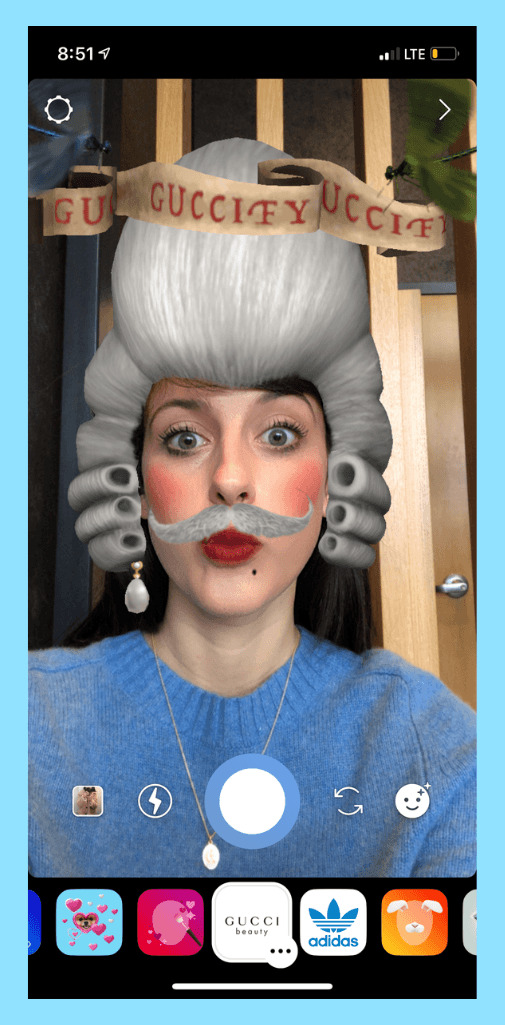
Rare Beauty, the brand founded by Selena Gomez, harnesses the power of filters to enhance its sales and brand presence. By integrating AR filters into its marketing strategies, Rare Beauty provides potential customers with immersive and interactive experiences, allowing them to virtually try on makeup products before making a purchase. These filters not only showcase the brand's diverse range of cosmetics but also enable users to experiment with different looks and styles, boosting their confidence in the products. Furthermore, by incorporating AR filters into its social media campaigns, Rare Beauty engages with its target audience in a fun and innovative way, fostering a sense of community and connection among followers. This personalized and engaging approach not only drives sales but also strengthens brand loyalty, establishing Rare Beauty as a frontrunner in the cosmetics industry.
In conclusion, the integration of AI/AR filters into marketing strategies on social media platforms like TikTok and Instagram proves to be highly effective for brands. These filters offer a dynamic and interactive way to engage with audiences, enhancing brand visibility and driving consumer engagement (Geyser, 2019). Leveraging AI/AR filters allows brands to create memorable and immersive experiences for users, ultimately leading to increased brand awareness, customer loyalty, and sales. As such, incorporating AI/AR filters into marketing strategies should be a priority for brands seeking to capitalize on the vast potential of social media platforms and stay ahead in today's digital landscape.
References
Digital Filter. (2023). DevX. https://www.devx.com/terms/digital-filter/#:~:text=Definition%20of%20Digital%20Filter
Geyser, W. (2019, June 25). Instagram stories AR filters: What are they and how are brands using them? Influencer Marketing Hub. https://influencermarketinghub.com/instagram-stories-ar-filters/
Repetska, T. (2023, December 20). How to get the AI filter for videos? Reface Blog. https://blog.reface.ai/how-to-make-a-video-with-restyle-ai-filters/#:~:text=AI%20filters%20are%20powered%20by
Sofija, E. (2023). The power of AR filters in marketing: Why brands need to embrace the AR revolution. Www.linkedin.com. https://www.linkedin.com/pulse/power-ar-filters-marketing-why-brands-need-embrace-emma-sofija#:~:text=By%20implementing%20AR%20filters%20into
What is “TikTok made me buy it”? (n.d.). NRF. https://nrf.com/blog/what-tiktok-made-me-buy-it
#mda20009#filter#aifilter#ai#beauty#interaction#branding#marketingstrategy#tiktokmademebuyit#rare beauty#selena gomez#gucci
0 notes
Text
WEEK 5: Digital Citizenship and Political Engagement and Activism
DIGITAL CITIZENS’ RIGHTS AND RESPONSIBILITIES
According to Rights and Responsibilities - Digital Citizenship Education (DCE) - Www.coe.int (n.d.), digital citizens can appreciate rights of security, get to and consideration, opportunity of expression and more. In any case, with those rights come certain duties, such as morals and sympathy and other duties to guarantee a secure and dependable computerized environment for all. In the digital age, users are endowed with both rights and responsibilities that shape their interactions and experiences within online spaces. Among the fundamental rights of digital users are privacy and security, encompassing the right to control personal data and safeguard against unauthorized access or exploitation. Additionally, users have the right to freedom of expression, allowing for the open exchange of ideas and opinions while respecting the rights and dignity of others. However, these rights come hand in hand with responsibilities.
Digital users bear the responsibility to uphold ethical behavior, including honesty, integrity, and respect for diversity, in their online interactions. This involves refraining from cyberbullying, harassment, or spreading misinformation that could harm individuals or communities. Furthermore, users have a duty to be discerning consumers of digital content, critically evaluating information sources and avoiding the spread of false or misleading information. By embracing these rights and responsibilities, digital users can contribute to a more inclusive, secure, and ethical online environment for all (Choi, 2016). The rights and responsibilities of digital citizens are shown in the table below.
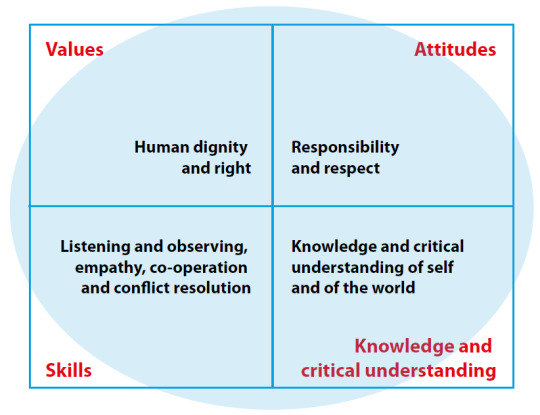
DIGITAL CITIZENS’ POWER THROUGH HASHTAG
According to research (Focus, 2023), hashtags play a pivotal part in celebrity social media promotion, permitting celebrities to advance their brand, reach a more extensive group of onlookers, and interface with their supporters. By utilizing important hashtags, celebrities can increment their perceivability, draw in modern adherents, and lock in with their existing fanbase(Focus, 2023). Take a drama of Taylor Swift and Kanye West as a case study for the power of hashtags on social media.


Anybody who's went through anytime on Twitter has likely seen a few frame of #IsOverParty trending. In its most common utilization, IsOverParty is composed after the title of somebody or something that's “canceled.” The drift formally picked up in July of 2016, when #TaylorSwiftIsOverParty started trending in reaction to the disclosure that Quick had known that Kanye West had composed approximately her in one of his melodies, “Famous,” referencing the time he hindered her acknowledgment discourse at the 2009 Video Music Grants. In that case, tweeters were criticizing Quick for implying meat between her and West, accepting that her information of the verses demonstrated that there were no hard sentiments. Within the four a long time since, #IsOverParty has been utilized endless times as a marker that somebody has done something the Twitter open regards inexcusable. Kanye West got his comeuppance more than once, when #KanyeWestIsOverParty trended each year between 2016 and 2019.
Twitter has seen a spike within the drift since the coronavirus widespread started, adjusting with the common increment in celebrity and lawmaker “cancelations.” #JimmyKimmelIsOverParty and #TinaFeyIsOverParty were utilized in late June to criticize both TV identities for utilizations of blackface on their TV shows.Generally, on the off chance that #IsOverParty is trending, clicking on it'll drag up tweets that clarify what the individual has done to merit such a party.
References
Choi, M. (2016). A Concept Analysis of Digital Citizenship for Democratic Citizenship Education in the Internet Age. Theory & Research in Social Education, 44(4), 565–607. https://doi.org/10.1080/00933104.2016.1210549
Focus, A. L. (2023, February 11). Which Hashtags Do Celebrities Use in Their Social Media Accounts? They Use latest-hashtags.com! News.abplive.com. https://news.abplive.com/brand-wire/which-hashtags-do-celebrities-use-in-their-social-media-accounts-they-use-latest-hashtags-com-1581491#:~:text=Conclusion-
Gelman, L. (2020, August 13). Twitter Explained | Who is Over and Where’s the Party? Moment Magazine. https://momentmag.com/twitter-explained-who-is-over-and-wheres-the-party/Rights and Responsibilities - Digital Citizenship Education (DCE) - www.coe.int. (n.d.). Digital Citizenship Education (DCE). https://www.coe.int/en/web/digital-citizenship-education/rights-and-responsibilities#:~:text=Digital%20citizens%20can%20enjoy%20rights
0 notes
Text
WEEK 4: Digital Community and Fandom: Reality TV Case Study
REALITY TV SHOW IN VIETNAM
According to the research (T , 2013), reality shows have become increasingly popular in Vietnam, reflecting a growing appetite for entertainment that offers a glimpse into the lives of everyday people. These shows cover a diverse range of themes, from talent competitions to lifestyle documentaries. One notable aspect of reality television in Vietnam is its ability to showcase local culture and traditions, providing a platform for contestants to share their stories and experiences. These shows often feature a mix of drama, humor, and emotional moments, captivating audiences and sparking discussions across the country. With the rise of streaming platforms and social media, reality shows in Vietnam have evolved to incorporate interactive elements, allowing viewers to engage with contestants and influence the outcome of competitions. Overall, reality television has emerged as a significant part of the entertainment landscape in Vietnam, reflecting the country's vibrant culture and diverse storytelling.
CASE STUDY “CHI DEP DAP SONG RE GIO”
"Chị Đẹp Đạp Sóng Rẽ Gió" (loosely translated as "Sister Beauty: Breaking Waves") stands out in Vietnam's reality TV landscape for its unique approach in providing opportunities for lesser-known artists to showcase their talents. This show has proven to be a platform where aspiring talents, often overlooked by mainstream media, can shine and gain recognition. By featuring a diverse array of contestants from various backgrounds, the show not only celebrates individual creativity but also fosters inclusivity within the entertainment industry. Moreover, "Chị Đẹp Đạp Sóng Rẽ Gió" goes beyond mere competition; it creates connections between artists, fostering collaboration and mutual support. Through shared experiences and challenges, contestants forge bonds that extend beyond the confines of the show, leading to future collaborations and friendships. Additionally, the show's emphasis on audience engagement facilitates a direct connection between artists and fans. Viewers become emotionally invested in the journeys of contestants, supporting them through votes, social media interactions, and attendance at live events. This interaction not only boosts the morale of artists but also cultivates a loyal fan base that continues to support their favorite contestants beyond the show's conclusion. In this way, "Chị Đẹp Đạp Sóng Rẽ Gió" serves as a catalyst for talent discovery, artistic collaboration, and the strengthening of bonds between artists and their audience, leaving a lasting impact on Vietnam's entertainment industry.
INFLUENCE OF FANDOM AND REALITY SHOWS
Reality shows have become increasingly popular in Vietnam, reflecting a growing appetite for entertainment that offers a glimpse into the lives of everyday people. These shows cover a diverse range of themes, from talent competitions to lifestyle documentaries (Berman, 2022). One notable aspect of reality television in Vietnam is its ability to showcase local culture and traditions, providing a platform for contestants to share their stories and experiences. These shows often feature a mix of drama, humor, and emotional moments, captivating audiences and sparking discussions across the country (Linh , 2018). With the rise of streaming platforms and social media, reality shows in Vietnam have evolved to incorporate interactive elements, allowing viewers to engage with contestants and influence the outcome of competitions. Overall, reality television has emerged as a significant part of the entertainment landscape in Vietnam, reflecting the country's vibrant culture and diverse storytelling.
REFERENCES
Berman, J. (2022, August 4). Reality TV Has Reshaped Our World, Whether We Like It or Not. Time. https://time.com/collection/reality-tv-most-influential-seasons/6199108/reality-tv-influence-on-world/
Linh , H. (2018). Do reality TV shows brings fame or shame? Vietnamnews.vn. https://vietnamnews.vn/talk-around-town/466740/do-reality-tv-shows-brings-fame-or-shame.htmlT , V. (2013). Báo VietnamNet. VietNamNet News. https://vietnamnet.vn/en/reality-shows-high-in-quantity-low-in-quality-E58079.html
0 notes
Text
Week 3: How does Tumblr function as a digital community?
WHAT IS TUMBLR?
Tumblr is a microblogging and social networking platform that allows users to publish multimedia content in the form of short blogs. Founded in 2007, it gained popularity due to its user-friendly interface and ability to easily share a variety of content, including text, photos, quotes, links, audio, and video. Tumblr allows its users to follow each other, like and reblog posts, and also participate in social networks where content is shared and distributed within the community. Take the fandom of Taylor Swift named Swifties as a case study, below are reasons Tumblr is considered as a digital community.
TUMBLR FUNCTIONS AS A DIGITAL COMMUNITY
Followers and Following
Tumblr gives its users the opportunity to put through and construct a computerized community through its interesting stage. Users can take after others and, in turn, pick up devotees, cultivating a sense of interconnecting inside the Tumblr environment. This social organizing location is known for its accentuation on inventive expression, permitting people to share a wide extent of substance, counting content, pictures, and mixed media. As clients clergyman their blogs and investigate the different substances created by others, Tumblr is an energetic space where like-minded people can find, lock in, and connect. For example, on Tumblr, the fandom community of Taylor Swift can encourage the trade of thoughts and cultivate a sense of community, making it a dynamic online space for expression and association.
Customization
Tumblr users have a high degree of customization for their blogs, counting topics, formats, and other plan components. This customization empowers clients to precise their independence and make a one of a kind online nearness. When searching hashtag #taylorswift or anything else relating to this famous singer, there are hundreds of posts with picture, caption, hashtag that the fandom can recognize each other easily, and it not only helps create a signature appearance for this community but also separate this community from the others on Tumblr.
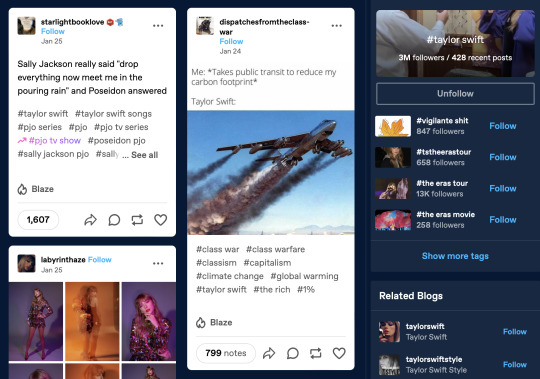
Community Guidelines
According to Growzilla (2023), “guidelines help set expectations and maintain a respectful atmosphere” and most of the communities on Tumblr have their own guidelines and policies in publishing content policies that force their members to follow. These guidelines not only help maintain a safe and respectful environment for users (Starke, 2015) but also create representation for their digital community. The community of Taylor Swift's fandom on Tumblr also has some guidelines that Swifties need to follow when joining their community.

References
Chang, Y, Tang, L, Inagaki, Y & Liu, Y 2014, “What is Tumblr,” ACM SIGKDD Explorations Newsletter, vol. 16, no. 1, Association for Computing Machinery (ACM), pp. 21–29, accessed <http://dx.doi.org/10.1145/2674026.2674030>
Growzilla. (2023). Building Online Communities: Strategies for Creating a Thriving Digital Community. Www.linkedin.com. https://www.linkedin.com/pulse/building-online-communities-strategies-creating-thriving
Haimson, O. L., Dame-Griff, A., Capello, E., & Richter, Z. (2019). Tumblr was a trans technology: the meaning, importance, history, and future of trans technologies. Feminist Media Studies, 21(3), 1–17. https://doi.org/10.1080/14680777.2019.1678505
Interactive, F. S. C. (2015, January 12). Taylor Swift, Tumblr, and #catitude. FSC Interactive. https://fscinteractive.com/blog/taylor-swift-tumblr-catitude/
Starke, L. (2015, December 14). Nine Characteristics of Online Communities That Work. Higher Logic. https://www.higherlogic.com/blog/nine-characteristics-of-online-communities-that-work/
1 note
·
View note